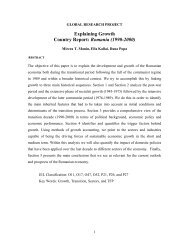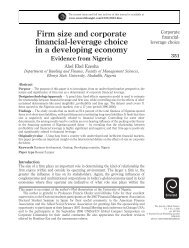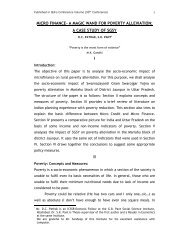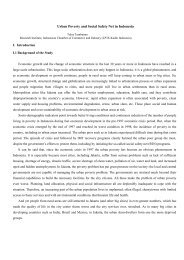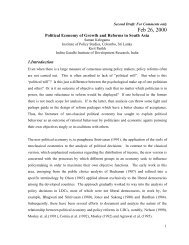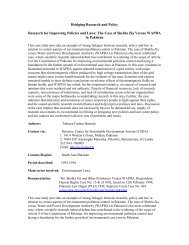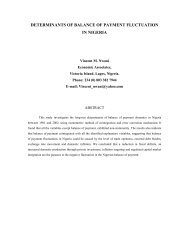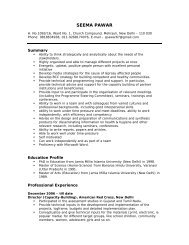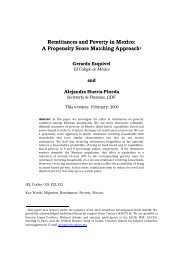Natural Resources, Development and Conflict: Channels of ...
Natural Resources, Development and Conflict: Channels of ...
Natural Resources, Development and Conflict: Channels of ...
You also want an ePaper? Increase the reach of your titles
YUMPU automatically turns print PDFs into web optimized ePapers that Google loves.
<strong>Natural</strong> <strong>Resources</strong>, <strong>Development</strong> <strong>and</strong> <strong>Conflict</strong>: <strong>Channels</strong> <strong>of</strong> Causation<strong>and</strong> Policy InterventionsPaul CollierOxford University <strong>and</strong> the World BankAbstractMany governments <strong>of</strong> developing countries receive large revenues derived from taxation <strong>of</strong> naturalresource rents. The developmental consequences <strong>of</strong> these revenues have <strong>of</strong>ten been negative <strong>and</strong> are clearlyfar below their potential. This paper focuses on how developed country governments could assist recipientgovernments to make better use <strong>of</strong> their own resources. It first considers six routes by which naturalresource rents create problems: rent-seeking, encouraging secession, financing rebellion, the detachment <strong>of</strong>government, Dutch disease, <strong>and</strong> exposure to shocks. It then proposes four remedies which address theseproblems – revenue transparency, the scrutiny <strong>of</strong> expenditures, the tracking <strong>of</strong> commodity flows, <strong>and</strong> theprovision <strong>of</strong> cushions for shocks.Key words: natural resources, governance, conflict1. Introduction<strong>Natural</strong> resources are distributed r<strong>and</strong>omly over the surface <strong>of</strong> the earth. As with anyr<strong>and</strong>om distribution the outcome is unequal. Some countries have few or no valuablenatural resources, <strong>and</strong> some others have many. Abundance brings opportunities forenhanced income <strong>and</strong> historically resource endowments such as coal <strong>and</strong> iron ore were<strong>of</strong>ten critical as triggers <strong>of</strong> development. However, at least over the past four decades,resource abundance has <strong>of</strong>ten been associated with problems <strong>of</strong> unfulfilled economicgrowth potential <strong>and</strong> high risks <strong>of</strong> large-scale violent conflict. That good fortune shouldbe turned into a problem is evidently avoidable <strong>and</strong> recently the international communityhas become interested in whether there are feasible collective actions that couldsignificantly mitigate the problem. In identifying possible ameliorating interventions, it isuseful to consider the reasons why natural resource dependence might have adverseeffects. Of course, the remedy for a problem need not be to address its cause;nevertheless, without underst<strong>and</strong>ing the causes we can have little confidence in proposedremedies.2. The association between natural resources <strong>and</strong> poor outcomesThe association between natural resources <strong>and</strong> the risk <strong>of</strong> civil war has recently beenexplored both through econometrics <strong>and</strong> case studies. The case study evidence is moreappropriate for underst<strong>and</strong>ing the causal mechanisms that are at work, while theeconometrics is more appropriate for establishing whether there is any causal relationshipto be understood.The first econometric study to find a relationship between natural resources <strong>and</strong> the risk<strong>of</strong> civil war was Collier <strong>and</strong> Hoeffler (1998). In the latest version <strong>of</strong> our work (Collier<strong>and</strong> Hoeffler 2004a) we analyze 54 large scale civil wars that occurred between 1965 <strong>and</strong>
1999. We find that a higher share <strong>of</strong> primary commodity exports in GDP significantly<strong>and</strong> substantially increases the risk <strong>of</strong> conflict. For example, if we compare countries with10% <strong>and</strong> 25% <strong>of</strong> their GDP coming from natural resources, holding other characteristicsconstant at the mean for low-income developing countries, the risk <strong>of</strong> a civil war in thesubsequent five years rises from 11% to 29%. We investigate whether there aresignificant differences between groups <strong>of</strong> commodities <strong>and</strong> find that oil is the only onewhich is distinctive. High levels <strong>of</strong> oil dependence are even more likely to be associatedwith conflict than similarly high levels <strong>of</strong> dependence upon other commodity exports. Itshould be stressed that natural resource dependence – or indeed the wider concept <strong>of</strong>primary commodity dependence – is far from being the only factor that is statisticallysignificant in the risk <strong>of</strong> conflict. In particular, the level <strong>of</strong> per capita income stronglyinfluences the risk <strong>of</strong> conflict. At high levels <strong>of</strong> per capita income the risk <strong>of</strong> civil war isnegligible with or without natural resources. Hence, societies such as Norway <strong>and</strong>Australia, which are highly dependent upon natural resource exports but are also rich, donot face any significant risk coming from their natural resource endowments.Several studies have investigated the relationship between natural resources <strong>and</strong> theduration <strong>of</strong> conflict as distinct from the risk <strong>of</strong> its initiation. Fearon <strong>and</strong> Laitin (2003)find that resource dependence increases the duration <strong>of</strong> civil war. Collier, Hoeffler <strong>and</strong>Soderbom (2004) get a similar result. Interestingly, they can distinguish between initialdependence <strong>and</strong> the effect <strong>of</strong> the world price <strong>of</strong> the commodity exports during theconflict. The advantage <strong>of</strong> this is that the world price is almost entirely exogenous to anindividual conflict <strong>and</strong> very easily observed, so it is a particularly reliable causal variable.Unsurprisingly, we find that the effect <strong>of</strong> the price depends upon the initial level <strong>of</strong>resource exports. Taking as an example a fairly high level <strong>of</strong> primary commodity exports<strong>of</strong> 30% <strong>of</strong> GDP at the start <strong>of</strong> the conflict, a subsequent <strong>and</strong> sustained increase in theworld price <strong>of</strong> the export by 10% would extend the duration <strong>of</strong> the conflict by 12%.The association between natural resource dependence <strong>and</strong> disappointing growthperformance is also supported both by econometric evidence <strong>and</strong> case studies. The bestknown <strong>of</strong> the econometric studies is Sachs <strong>and</strong> Warner (2001) which finds that naturalresources reduce growth. There are many good case study collections. A particularlygood analysis <strong>of</strong> oil economies is Gelb (1989).3. Routes from <strong>Natural</strong> Resource Dependence to <strong>Development</strong> ProblemsBy their nature, these econometric studies are usually not well-suited to explain whythese associations are found. In this Section I suggest six causal mechanisms, relyingprimarily upon a mixture <strong>of</strong> theory <strong>and</strong> case study evidence. Ross (2003) <strong>and</strong> Isham(2003) provide excellent analyses <strong>of</strong> this evidence.Rent-seeking <strong>of</strong> honeypotsOne obvious potential explanation is that natural resources constitute a valuable honeypotover which interest groups might fight. Surprisingly, the evidence for this is relativelyweak. If this were an important explanation we might expect that it should also apply to
aid, <strong>and</strong> indeed one economic theorist <strong>of</strong> conflict, Grossman (1992), has proposedprecisely this relationship. Some governments receive very large aid inflows, <strong>and</strong> so togain access to the aid it should be advantageous to capture the government. When aid isinstrumented <strong>and</strong> introduced into the Collier-Hoeffler model <strong>of</strong> conflict risk, it has nosignificant direct effect. 1 Nevertheless, it may be that natural resources are a more evidentsource <strong>of</strong> rent than aid.Some case studies point to the importance <strong>of</strong> the pure rent-seeking motive in particularcases. In Fiji an attempted violent coup d’Etat was launched by a businessman who wasthe local representative <strong>of</strong> a private American company seeking a logging contract. Thecoup came shortly after the contract had been awarded to a different company. In SierraLeone, the leader <strong>of</strong> the RUF rebel group was <strong>of</strong>fered the Vice-Presidency <strong>of</strong> the countryin a peace deal, but refused until the <strong>of</strong>fer was changed to include his chairmanship <strong>of</strong> theboard controlling diamond mining interests. Despite attempts in both these cases for therebel leaders to put a different interpretation on their actions, the conclusion that rentseeking<strong>of</strong> natural resources played a substantial part in motivating their actions is surelyunavoidable.It is <strong>of</strong>ten difficult to distinguish between purely criminal predation <strong>and</strong> that which isintended to fund a political objective. Sometimes, indeed, the objective can change overtime. For example, the FARC began as a rural radical political movement, but is nowsurely predominantly a drugs operation. Presumably, as drug revenues becameincreasingly central to what the organization was doing, idealists motivated by ideologybecame less likely to join, <strong>and</strong> criminals attracted by wealth <strong>and</strong> violence became morelikely to join. Similarly, in the Delta region <strong>of</strong> Nigeria, a movement that was initiallyprotesting against injustice <strong>and</strong> environmental degradation, relatively rapidly evolved intogang warfare between villages for the control <strong>of</strong> the right to run protection <strong>and</strong>kidnapping rackets, <strong>and</strong> by 2004 had reached a scale where its leaders were in a positionto negotiate with the Nigerian state.Making secessionist movements credibleA variant on the honeypot hypothesis for which there is much better evidence is thatnatural resource abundance promotes violent secession. Just as the distribution <strong>of</strong> naturalresources between countries is not equal, so within favored countries some locations arefavored more than others. The people living in the vicinity <strong>of</strong> the natural resourceendowment have an obvious economic interest in claiming the resources for themselvesto the exclusion <strong>of</strong> their fellow nationals. Since natural resources are almost everywheretreated as public rather than private property, such a claim for local public ownership istantamount to a claim for independence. Nation states are usually recent agglomerations<strong>of</strong> previously distinct political entities, <strong>and</strong> this process <strong>of</strong> assimilation has <strong>of</strong>ten beencontested. Hence, in many situations, natural resources will be located in regions wheresome political groups – albeit <strong>of</strong>ten on the fringe – are already claiming autonomy. Thepresence <strong>of</strong> natural resources enables such groups to add a credible economic argument1 Indirectly, aid reduces the risk <strong>of</strong> conflict through its effect upon economic growth. See Collier <strong>and</strong>Hoeffler (2004c).
to what is otherwise likely to be a largely romantic appeal. An example <strong>of</strong> thistransformation is the (non-violent) rise <strong>of</strong> Scottish nationalism which can be preciselydated to between the 1970 <strong>and</strong> 1974 elections. At the former election, as in all previouselections, the Scottish National Party won only a tiny share <strong>of</strong> the vote <strong>and</strong> gained only asingle seat in parliament. In the two 1974 elections its vote rose to 30%. Thetransforming event that brought about this change was surely the dramatic rise in theworld oil price in late 1973 as a result <strong>of</strong> the Yom Kippur war. The oil <strong>of</strong>f the shores <strong>of</strong>Scotl<strong>and</strong> was suddenly seen as valuable: the party campaigned on the slogan ‘itsScotl<strong>and</strong>’s oil’. Indeed, speculation at the time may well have inflated its imagined valuefar in excess <strong>of</strong> its true value. OPEC appeared to have the power to raise the price almostwithout limit, <strong>and</strong> the Shah <strong>of</strong> Iran began speaking <strong>of</strong> oil as ‘the noble fuel’, giving oilendowments an aura <strong>of</strong> unrivalled affluence. A similar oil-influenced secessionistmovement, this time violent, was Biafra in Nigeria. Biafra’s move to violent secessionoccurred after fiscal decisions to treat oil revenue as a national asset. Although there wereethnic tensions in Nigeria, virtually all African countries have several ethnic groups. It issurely striking that the ethnic groups in Africa that have attempted to secede have usuallybeen resource rich, such as in Biafra <strong>and</strong> Katanga.Usually, ethnic groups in regions that are poorly endowed do not press for secession, forthe obvious reason that they would be worse <strong>of</strong>f. Where romantic secessionistsnevertheless manage to build a politically powerful dem<strong>and</strong> for secession – perhapsbecause they have an unusually charismatic leader – the other regions <strong>of</strong> the country maydecide to grant secession peacefully since it is not worth violent opposition. Such was thecase in Czechoslovakia, where the poorer region <strong>of</strong> Slovakia was permitted by the larger<strong>and</strong> richer Czech region to secede peacefully.Collier <strong>and</strong> Hoeffler (2004b) analyze secession statistically. First, we rely upon thepolitical science classification <strong>of</strong> civil wars into secessionist versus ideological. This isnot an immaculate distinction, depending to an extent upon the ostensible objectives <strong>of</strong>rebel groups. However, given this classification, we test whether primary commodityexports have differential effects on the risk <strong>of</strong> the two types <strong>of</strong> civil war. We find thatprimary commodity dependence indeed increases the risk <strong>of</strong> secessionist war more than itincreases the risk <strong>of</strong> an ideological war. We then focus specifically on oil <strong>and</strong> find that ifan oil exporting country experiences a civil war it is almost certain to be a secessionistwar in contrast to non-oil exporters which <strong>of</strong>ten experience ideological civil wars.Oil may be distinctive in its romantic connotations <strong>of</strong> affluence. For example, the GAM,the rebel movement that has been attempting to achieve secession <strong>of</strong> Aceh fromIndonesia, has used the analogy <strong>of</strong> Brunei in its propag<strong>and</strong>a, claiming that the population<strong>of</strong> Aceh could be equally rich. This is a massive, <strong>and</strong> presumably deliberate exaggeration,but may well appeal to the popular imagination.Financing rebel groupsA further way in which primary commodities in general <strong>and</strong> natural resources inparticular can increase the risk <strong>of</strong> civil war is through their vulnerability to predation by
ebel groups who need finance to pursue violence. Rebellion is usually expensive.Recruits are usually full time <strong>and</strong> so need to be housed, clothed <strong>and</strong> fed. Moreparticularly, armaments are expensive <strong>and</strong> tend to wear out rapidly in combat conditionswith ill-trained fighters. Most would-be rebel groups simply cannot finance theiractivities on a scale beyond minor acts <strong>of</strong> terrorism. <strong>Natural</strong> resource predation is by nomeans the only source <strong>of</strong> finance for a rebel army, but where natural resources abound inrural areas they are uniquely vulnerable because they are difficult to defend, lucrative <strong>and</strong>immobile. The task <strong>of</strong> extorting rents from rurally-based natural resource industries alsorequires a technology <strong>of</strong> violence that is very similar to that which rebel groups in anycase need for warfare. This is in contrast to urban-based extortion rackets, wheresubstantial levels <strong>of</strong> armaments beyond basic h<strong>and</strong>guns would be an encumbrance ratherthan an asset.The most spectacular examples <strong>of</strong> natural resource funded rebel groups come fromdiamonds. UNITA <strong>and</strong> the RUF both grew to remarkably big organizations – at one stageUNITA is believed to have had 150,000 men. Such large st<strong>and</strong>ing armies are hugelyexpensive <strong>and</strong> depend upon correspondingly large resource predation businesses. Alluvialdiamonds are particularly well-suited for predation, because the extraction process issufficiently simple that it does not require large corporations. Thous<strong>and</strong>s <strong>of</strong> smallindividual operators are in a much weaker position to defend themselves than largecompanies, so that the rebel organization is easily able to intimidate <strong>and</strong> informally taxproducers. Timber is also technologically suited to rebel predation, as with the KhmerRouge in Cambodia. Where technology requires large companies, as in the case <strong>of</strong> oil,rebel groups can still be predatory, but the natural <strong>of</strong> the predation changes. Companiesare threatened with sabotage <strong>of</strong> pipelines, <strong>and</strong> their employees are kidnapped <strong>and</strong>ransomed. However, it is becoming increasingly difficult for MNCs to make suchpayments to large rebel groups.A related phenomenon is ‘war booty futures’ (Ross, 2003). Here the rebel group actuallyneeds a large company to which it can sell the highly risky prospect <strong>of</strong> extraction rightscontingent upon subsequent rebel victory.Detaching the government from the electorateHistorically, representative government arose because states needed to raise largerevenues in order to fight wars <strong>and</strong> found that conceding some degree <strong>of</strong> representation totaxpayers was the necessary price <strong>of</strong> popular compliance in taxation. A common politicaleconomy argument, applied to both natural resource revenues <strong>and</strong> aid, is that by reducingthe need for taxation they also reduce popular scrutiny <strong>of</strong> government. People are lessconcerned about the misuse <strong>of</strong> public money if they have not been taxed in order togenerate it. The power <strong>of</strong> this argument depends upon the sophistication <strong>of</strong> the electorate.In principle, the opportunity cost <strong>of</strong> misused public money is the same regardless <strong>of</strong> itssource. However, governments that misuse public funds can more easily disguise theextent <strong>of</strong> natural resource revenues than they can disguise taxation. It may also be easy toco-opt the relatively small groups <strong>of</strong> informed potential critics <strong>of</strong> natural resource misuse.
A variant on this ‘detachment’ argument, is that resource rents might provide thegovernment with a different option <strong>of</strong> retaining support. My current research withHoeffler finds that natural resource rents systematically subvert the functioning <strong>of</strong>democracy. Whereas in the absence <strong>of</strong> natural resource rents democracies outperformautocracies, in the presence <strong>of</strong> large rents democratic performance so deteriorates thatautocracies outperform them. Perhaps, large resource rents enable leaders to maintainpower through private patronage rather than the public goods that democracy would otherforce them to supply.To the extent that the government is more detached from electoral concerns if it hassubstantial natural resource revenues, this is both a bad in itself <strong>and</strong> a potential cause <strong>of</strong>rebellion, including secession. The perception that resources are being embezzled by acorrupt elite is at the least convenient for rebel groups. In practice, there is seldom asingle motivation for rebellion, <strong>and</strong> the perception <strong>of</strong> government corruption can be acontributing factor even if it is not by itself a significant trigger <strong>of</strong> violence.Dutch diseaseThirty years ago the academic economics community made much <strong>of</strong> the problem <strong>of</strong>Dutch disease – the tendency for natural resource exports to appreciate the real exchangerate <strong>and</strong> so make the production <strong>of</strong> other tradable goods less competitive. As described,the response is simply an efficient resource reallocation – resources move into the nontradablesector, producing the goods that the now-richer society dem<strong>and</strong>s but that cannotbe supplied through imports. To be a ‘disease’ one or other <strong>of</strong> two additions arecommonly invoked. The first is that the real appreciation is temporary but that theimplied inter-temporal path <strong>of</strong> relative prices is insufficiently recognized by privateagents. As a result, resources are lured into the non-tradable sector, where they aresubsequently marooned once prices revert. Excessive adjustment costs are incurred. Thesecond addition is to suppose that externalities such as some learning-by-doing are moresubstantial in the non-natural resource tradable sector, so that growth rates can bereduced.The same critique is sometimes made <strong>of</strong> aid, since indeed it has the same effect <strong>of</strong>appreciating the real exchange rate. The effect <strong>of</strong> aid on growth has been extensivelydebated. Collier <strong>and</strong> Dollar (2002) use a reduced-form approach which controls forpolicy, <strong>and</strong> so in principle controls for the ‘detachment’ effect that both aid <strong>and</strong> naturalresources are also likely to have in common. They find that there are diminishing returnsto aid that in turn depend upon policy. They term the point at which the effect on growthturns negative the ‘saturation point’. When policies are reasonable, aid contributes togrowth up to levels <strong>of</strong> around 20-30% <strong>of</strong> GDP. When policies are poor, the saturationpoint occurs when aid is around 10-15% <strong>of</strong> GDP. Since natural resource revenues areclosely analogous to aid, at least for a given policy environment, we would expect thatthis range <strong>of</strong> absorptive capacity would apply to both aid <strong>and</strong> natural resource revenues.The diminishing returns that drive the economy to the saturation point, beyond which aid– <strong>and</strong> by implication natural resources - actually reduces growth, might well reflect Dutchdisease. That is, such resources might have a beneficial effect which is subject to the
normal process <strong>of</strong> diminishing returns, <strong>and</strong> an adverse effect – Dutch disease – whicheventually becomes preponderant. Many resource-abundant countries are indeed likely tobreach the ‘saturation point’, being in the range over which at the margin natural resourcerevenues have a net adverse effect. This is partly because revenues are sometimes veryhigh - in excess <strong>of</strong> 30% or even 40% <strong>of</strong> GDP, as in Nigeria. However, it is also becausepolicies are <strong>of</strong>ten very poor, perhaps because <strong>of</strong> the ‘detachment’ effect, so that thesaturation point sets in at relatively low levels <strong>of</strong> revenue. Indeed, dynamically there maybe a trap. With poor policies <strong>and</strong> high levels <strong>of</strong> natural resource revenue, the non-naturalresource part <strong>of</strong> the economy is likely to have slow or even negative growth, <strong>and</strong> sodiminish relative to the natural resource component. It is then in a weak position to lobbyfor reform. Such for example has been the fate <strong>of</strong> the Nigerian economy, where the nonoileconomy has been virtually stagnant for a long period. Hence, whether Dutch diseaseis a problem warranting attention is likely to depend on both the scale <strong>of</strong> the resourcerevenues, <strong>and</strong> on the policy environment.Exposure to shocksThe final route by which natural resources, <strong>and</strong> indeed other primary commodities, canbe problematic for development is due to their exposure <strong>of</strong> the economy to price shocks.Large negative shocks tend to produce episodes <strong>of</strong> severe economic contraction whichcompound the direct loss <strong>of</strong> income. Such episodes directly increase poverty due to thefall in export income. They also tend to reduce the growth rates <strong>of</strong> output over themedium term (Collier <strong>and</strong> Dehn, 2001). Over <strong>and</strong> above the income <strong>and</strong> output losses,Hoeffler <strong>and</strong> I find that episodes <strong>of</strong> rapid economic decline substantially increase the risk<strong>of</strong> civil war. Even positive shocks sometimes destabilize economic management <strong>and</strong> soare missed opportunities. The subject is taken up further in Guillaumont (2003, 2004).4. International Policy Responses to these ProblemsThe six routes reviewed in Section 3 whereby the contribution <strong>of</strong> natural resourceendowments to development might be disappointing may not all apply in any oneparticular context. However, they may each be sufficiently likely to apply in enoughcontexts to be a cause for international concern. Yet they are very different one fromanother. Evidently, no single policy intervention will address all six routessimultaneously. Therefore, if all are indeed credible routes, as seems likely, what will berequired is a package <strong>of</strong> interventions which collectively addresses all <strong>of</strong> the routes. Inthe absence <strong>of</strong> a package, interventions that address only a single route may have limitedeffect. If one adverse channel is closed, this may increase the opportunities for the otherchannels to take effect.I now consider the components <strong>of</strong> a feasible package. They are addressed in more detailin Collier et al. (2003) <strong>and</strong> Bannon <strong>and</strong> Collier (2003). Although there are six routes,some interventions address more than one <strong>of</strong> them, so that I think an effective packageneed have only four components. These are: revenue transparency; expenditure scrutiny;commodity tracking; <strong>and</strong> reduced exposure to price shocks. I now consider the first threein turn, the fourth being dealt with the papers <strong>of</strong> Guillaumont (2004).
Revenue TransparencyRevenue transparency is useful in several respects. First, it is evidently a necessary inputinto scrutiny <strong>of</strong> expenditures – unless revenues are known, it is pointless to ask how theyare used. A corollary <strong>of</strong> this is that secrecy <strong>of</strong> revenues will dampen efforts to scrutinizeexpenditures. In terms <strong>of</strong> the six routes discussed above, transparency is necessary toaddress the problem <strong>of</strong> ‘detachment’. In addition, transparency can reduce the problem <strong>of</strong>secessionist pressure. Recall from the example <strong>of</strong> the GAM in Aceh that rebelmovements will deliberately attempt to exaggerate the value <strong>of</strong> natural resource revenues.Far from keeping the population quiescent, secrecy is likely to facilitate suchexaggeration. Transparency alone is not sufficient to counter such propag<strong>and</strong>a, for manygovernments <strong>of</strong> developing countries are not trusted by their populations to provideaccurate information, especially on such contested matters. The obvious counter <strong>of</strong> arebel group such as the GAM to government information campaigns showing lower oilrevenues than the group has implied, is simply to accuse the government <strong>of</strong>embezzlement. Hence, any system <strong>of</strong> transparency must also be credible to the domesticpopulation.The NGO Global Witness has led efforts to encourage transparency, arguing for reportingby individual resource extraction companies on a compulsory basis. While this has someattractions, it also has disadvantages. First, it is politically difficult to achieveinternational action on the basis <strong>of</strong> compulsion: some companies may see it as a breach <strong>of</strong>confidentiality, <strong>and</strong> the governments that receive natural resource revenues may see it asyet another developed country insinuation that they are corrupt. Secondly, if companieswere to report using different accounting years, or different concepts <strong>of</strong> revenue, it wouldbe impossible to arrive at a credible aggregate figure: individual reporting alone could, byproviding too much disaggregated information, paradoxically provide too littleinformation for effective scrutiny. The approach was also in danger <strong>of</strong> missing the keyrole played by national oil companies. An alternative approach, which has been suggestedby the UK government, is for companies to be required by the government <strong>of</strong> the naturalresource-rich country to report on a confidential basis to the World Bank, which wouldthen publish aggregate information. This has several advantages. First, the hostgovernment would have the choice as to whether to make reporting a requirement or not.Hence, it would not itself be the subject <strong>of</strong> compulsion but would rather be a criticalparticipant in producing transparency. Once a ‘template’ for revenue reporting isestablished, governments which required companies to report along the lines suggested inthe template would be signaling their commitment to honest governance. This ability tosignal would itself be most useful to governments that face a problem <strong>of</strong> poor reputation– it provides a mechanism whereby they can live down the past. Secondly, thegovernment would require all companies, including national companies, to report. Thiswould avoid the problem that were the reporting requirement to come from OECDcountries, it would apply only to some companies <strong>and</strong> so would disadvantage them – inturn making OECD countries reluctant to impose such discriminatory requirements.Third, by introducing an informed intermediary, such as the World Bank, the reporteddata can be required to conform to some st<strong>and</strong>ard concepts. This can reduce the problem
<strong>of</strong> misleading reporting, <strong>and</strong> can also facilitate meaningful aggregation. The intermediarycan then in turn report the aggregated data in a form which is sufficiently non-technical tomeet the spirit as well as the letter <strong>of</strong> transparency. Finally, because the government <strong>of</strong>the natural resource exporting country would be triggering the reporting process, it wouldbe natural for the corporate reporting to be accompanied by government disclosure <strong>of</strong>revenues received, so that claimed payments could be reconciled with claimed receipts.ScrutinyTransparency <strong>of</strong> revenues is itself an input into the scrutiny <strong>of</strong> expenditures. Withouttransparency <strong>of</strong> revenues scrutiny <strong>of</strong> expenditures loses much <strong>of</strong> its point, buttransparency is not in itself scrutiny. Scrutiny is predominantly a domestic process: this isbecause citizens <strong>and</strong> their representatives are the legitimate beneficiaries <strong>of</strong> publicrevenues. The donor community may also have a legitimate interest in scrutiny, to theextent that it is putting resources into the country, but this is distinctly secondary to thedomestic interest. While ever scrutiny depends solely upon the complaints <strong>of</strong> foreigngovernments <strong>and</strong> international agencies it will be easy for <strong>of</strong>fending governments todeflect the exposure using the tried <strong>and</strong> tested defensive strategy <strong>of</strong> nationalism.The purpose <strong>of</strong> the scrutiny is to establish how natural resource revenues are spent. Sincerevenues are fungible, this can only be done through scrutiny <strong>of</strong> the entire budgetaryprocess. In most resource-rich developing countries the institutions that would normallyundertake such scrutiny – parliamentary committees, allied with an auditor-general <strong>of</strong>fice<strong>and</strong> an investigative press – are currently insufficiently effective. Building the capacityfor scrutiny depends partly upon training, <strong>and</strong> partly upon a change on the part <strong>of</strong> thegovernment towards toleration, <strong>and</strong> even encouragement <strong>of</strong> investigation. Again, theproximate reward for such a change in behavior is greatest for those governmentsburdened by a poor reputation – whether with their own electorates or with foreigninvestors.In some contexts institutions <strong>of</strong> scrutiny need to be established from scratch. Forexample, in Chad as a result <strong>of</strong> the Chad-Cameroon pipeline new government institutionswere established, along with an ad hoc group including civil society <strong>and</strong> foreigncompanies. Experience to date suggests that even this ad hoc approach has been quiteeffective. The precise architecture <strong>of</strong> scrutiny would need to differ, country-by-country,depending upon what is already in place.Between them, transparency <strong>and</strong> scrutiny would address three <strong>of</strong> the six routes by whichnatural resources cause development problems. First, they would curtail the contest for‘honeypots’ because they would curtail the ability to divert resources to illegitimate uses.Secondly, they would reduce the incentive for secession. Secessionist groups would nolonger be able to exaggerate the scale <strong>of</strong> revenues, nor would they be able to contrast theprospect <strong>of</strong> local accrual <strong>of</strong> revenues with embezzlement at the national level. The bestdefense against secession is likely to be credible evidence that revenues are being usedfor nationally equitable expenditures such as primary education. Third, transparency <strong>and</strong>scrutiny provide at least some counter to the problem <strong>of</strong> ‘detachment’. Gradually, the
population may come to recognize that natural resource revenues are indeed owned bythe nation, so that how they are used is a core issue <strong>of</strong> domestic politics.Commodity TrackingCommodity tracking has recently been pioneered through the Kimberley process fortracking diamonds. The process is still in its infancy <strong>and</strong> there is a need to establish howeffective it is. However, if it is effective it could be scaled up to cover other commoditiessuch as timber <strong>and</strong> oil. The primary purpose <strong>of</strong> commodity tracking is to make it moredifficult for rebel groups to pr<strong>of</strong>it from looting valuable natural resources. Since majorrebel groups, such as UNITA, the RUF <strong>and</strong> the Khmer Rouge have used this as theirprimary source <strong>of</strong> revenue, there is considerable scope for using commodity tracking tocurtail rebel finance. The objective is not literally to keep rebel-looted commodities <strong>of</strong>fthe market, but rather to make them only salable at a deep price discount. The appropriateassessment <strong>of</strong> whether tracking is effective is therefore simply to observe the pricediscount that rebels need to <strong>of</strong>fer. While this is not public information, it is fairly readilyavailable from informed participants in the industry, <strong>and</strong> so it is far easier to monitor thanthe actual quantity <strong>of</strong> an illicit commodity coming onto the market.The physical tracking <strong>of</strong> commodities can also usefully be combined with information onthe financial transactions that are the counterpart <strong>of</strong> their physical movement. Suchintegration <strong>of</strong> financial reporting systems, for which banks are responsible, <strong>and</strong> physicalconsignments, which are reported by customs authorities, would be relativelystraightforward with modern information technology, <strong>and</strong> would greatly augmentinformation on transparency. At present, the reporting requirements <strong>of</strong> banks are beingconsiderably increased as a counter to corruption <strong>and</strong> international terrorism, <strong>and</strong> thereporting requirements for the physical movement <strong>of</strong> commodities are being increased,but the two have not been combined.These tracking strategies primarily address the problem that natural resources havehistorically been used to finance rebel movements. By improving transparency, they alsoaddress the problems <strong>of</strong> secession <strong>and</strong> ‘detachment’ – the government is seen to beattempting to curtail the illicit use <strong>of</strong> revenues.Reduced exposure to shocksThis part <strong>of</strong> the package is dealt with more thoroughly in Guillaumont (2004). The broadstrategies for reducing the exposure to price shocks are cushioning through public orprivate insurance, export diversification, <strong>and</strong> most ambitiously, to reduce the price shocksthemselves.Private insurance can be done through hedging on international commodity markets.Governments have seldom attempted such hedging <strong>and</strong> it is itself a risky process. Amajor disincentive is that hedging is politically very exposed – the strategy has anapproximately 50% chance <strong>of</strong> losing money, at least in the short term, <strong>and</strong> in this eventpolitical opponents will criticize the decision taker. It is risky because making contracts
in derivatives markets is a complex form <strong>of</strong> gambling, <strong>and</strong> if public <strong>of</strong>ficials arepermitted to engage in it they will sometimes be tempted to take risks instead <strong>of</strong> reducingthem. Supervising such staff is difficult <strong>and</strong> expensive. It may, however, be possible forthe World Bank to take on the management <strong>of</strong> hedging contracts – not itself entering themarket, but acting on behalf <strong>of</strong> client governments, <strong>and</strong> bearing the risk <strong>of</strong> staffsupervision. The Bank already manages the foreign exchange positions for somedeveloping countries <strong>and</strong> so the management <strong>of</strong> commodity hedges appears to pose noissues <strong>of</strong> principle.There are several options for public insurance. The Fund or the Bank could introduceconcessional lending facilities, triggered by sharp declines in export prices. The donorcommunity could channel aid in response to price shocks in the same way that itcurrently does for more photogenic shocks such as earthquakes <strong>and</strong> droughts. Finally, theBank is a major creditor to both commodity exporting countries <strong>and</strong> commodityimporting countries. The most important commodity here is oil. Currently, debt service tothe Bank by oil exporters is around $6 billion per year, <strong>and</strong> debt service by oil importersis around $12 billion per year. Hence, there is at least in principle the potential for thesetwo payments streams to move in a precisely <strong>of</strong>fsetting fashion, conditioned on the oilprice. When oil prices were high, oil exporters would take over some <strong>of</strong> the debt serviceobligations <strong>of</strong> oil importers <strong>and</strong> vice versa. The Bank would gain by reducing its defaultrisk, <strong>and</strong> both oil exporters <strong>and</strong> oil importers would gain from less volatile net incomes.Both diversification <strong>and</strong> the reduction in price volatility itself could be assisted bychanges in OECD trade policies. At present, tariff escalation by OECD countries reducesthe pr<strong>of</strong>itability <strong>of</strong> processing commodities in developing countries relative to resourceextraction. Setting agricultural subsidies that are contingent on the world price has theeffect <strong>of</strong> widening price swings. For example, when world cotton prices fell, the USgovernment increased subsidies to its cotton farmers. This further lowered the worldprice to cotton farmers in the Central African Republic.Directly, such strategies obviously address the problem <strong>of</strong> price volatility. However, incombination with transparency <strong>and</strong> scrutiny they also have the effect <strong>of</strong> reducing theproblem <strong>of</strong> Dutch disease. Recall that Dutch disease is best thought <strong>of</strong> in terms <strong>of</strong>absorptive capacity – how much natural resource revenue can the government useproductively. In turn, absorptive capacity is dependent upon the quality <strong>of</strong> the policyenvironment. By reducing economic fluctuations <strong>and</strong> improving the effectiveness <strong>of</strong>public expenditure absorptive capacity is increased, so that fewer countries would findthemselves in the range in which real exchange rate appreciation becomes the dominantconsideration.5. Conclusion<strong>Development</strong> agencies are now focusing on ‘aid effectiveness’ <strong>and</strong> ‘policy coherence’.By aid effectiveness is meant the need to increase the impact <strong>of</strong> aid on growth <strong>and</strong>poverty reduction; by policy coherence is meant the attempt to align apparently disparatepolicies such as aid <strong>and</strong> trade, to make them all supportive <strong>of</strong> development. <strong>Natural</strong>
esource revenues accruing to developing countries are far larger than aid flows, but theyare analytically similar. Policy coherence dem<strong>and</strong>s that the international communityshould pay attention to raising the returns to natural resource revenues, just as it hasstruggled to raise the returns on aid. Indeed, the pay-<strong>of</strong>f to raising the returns on naturalresource revenues dwarfs the effects <strong>of</strong> raising the returns on aid. Some <strong>of</strong> the actionsrequired are similar – such as domestic scrutiny – some are very different. But theprolonged international debate on aid effectiveness contrasts with the neglect that hasprevailed until recently on international policy towards natural resources.ReferencesBannon, Ian <strong>and</strong> Paul Collier (eds). (2003) <strong>Natural</strong> <strong>Resources</strong> <strong>and</strong> Violent <strong>Conflict</strong>:Actions <strong>and</strong> Options, World Bank.Collier, Paul, Lani Elliott, Havard Hegre, Anke Hoeffler, Marta Reynal-Querol <strong>and</strong>Nicholas Sambanis, (2003) Breaking the <strong>Conflict</strong> Trap: Civil War <strong>and</strong> <strong>Development</strong>Policy, Oxford University Press for World Bank.Collier, Paul <strong>and</strong> David Dollar, (2002) ‘Aid Allocation <strong>and</strong> Poverty Reduction’,European Economic Review, 46, 1475-1500.Collier, Paul <strong>and</strong> Jan Dehn (2001) ‘Aid, Shocks <strong>and</strong> Growth’, World Bank PolicyResearch Working Paper 2688.Collier, Paul <strong>and</strong> Anke Hoeffler (1998) ‘On the Economic Causes <strong>of</strong> Civil War’, OxfordEconomic Papers, 50, 563-73._________________________ (2004a) ‘Greed <strong>and</strong> Grievance in Civil War’, OxfordEconomic Papers, 56, 563-595._________________________(2004b) ‘The Political Economy <strong>of</strong> Secession’, in H.Hannum <strong>and</strong> E.F. Babbitt (eds.) Negotiating Self-Determination._________________________(2004c) ‘Violent <strong>Conflict</strong>’, in Bjorn Lomborg (ed.) GlobalProblems, Global Solutions, Cambridge University Press.Collier, Paul, Anke Hoeffler <strong>and</strong> Mans Soderbom, (2004) ‘On the Duration <strong>of</strong> CivilWar’, Journal <strong>of</strong> Peace Research.Fearon, James, <strong>and</strong> David Laitin (2003) ‘Ethnicity, Insurgency <strong>and</strong> Civil War’, AmericanPolitical Science Review, 97(1).Gelb, Alan <strong>and</strong> associates (1989) Oil Windfalls: Blessing or Curse?, Oxford UniversityPress.Grossman, Herschel (1992) ‘Foreign Aid <strong>and</strong> Insurrection’, Defence Economics, 3, 275-288.Guillaumont, P., S. Guillaumont Jeanneney, (2003) ‘Dampening Price Shocks’ in I.Bannon et P. Collier (eds.) <strong>Natural</strong> <strong>Resources</strong> <strong>and</strong> Violent <strong>Conflict</strong>. Options <strong>and</strong> Actions,World Bank.Guillaumont, P., S. Guillaumont Jeanneney, P. Jacquet, L. Chauvet et B. Savoye, (2004)‘Attenuating through Aid the Vulnerability to Price Shocks’, in F. Bourguignon <strong>and</strong> P.Jacquet (eds) Economic Integration <strong>and</strong> Social Responsibility, World Bank/OxfordUniversity Press.Isham, J., L. Pritchett, M. Woolcock <strong>and</strong> G. Busby, (2003) ‘The Varieties <strong>of</strong> the ResourceExperience: ‘How <strong>Natural</strong> Resource Export Structures Affect the Political Economy <strong>of</strong>Economic Growth’, mimeo, World Bank, Washington DC.
Ross, Michael (2003) ‘The <strong>Natural</strong> Resource Curse: How Wealth Can Make You Poor’,in Bannon <strong>and</strong> Collier (eds.).Sachs, Jeffrey, <strong>and</strong> Andrew Warner (2001) The Curse <strong>of</strong> <strong>Natural</strong> <strong>Resources</strong>, EuropeanEconomic Review, 45, 827-38.



